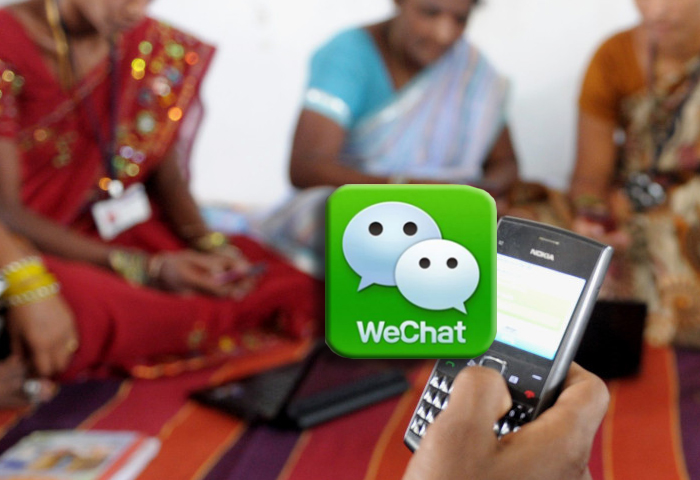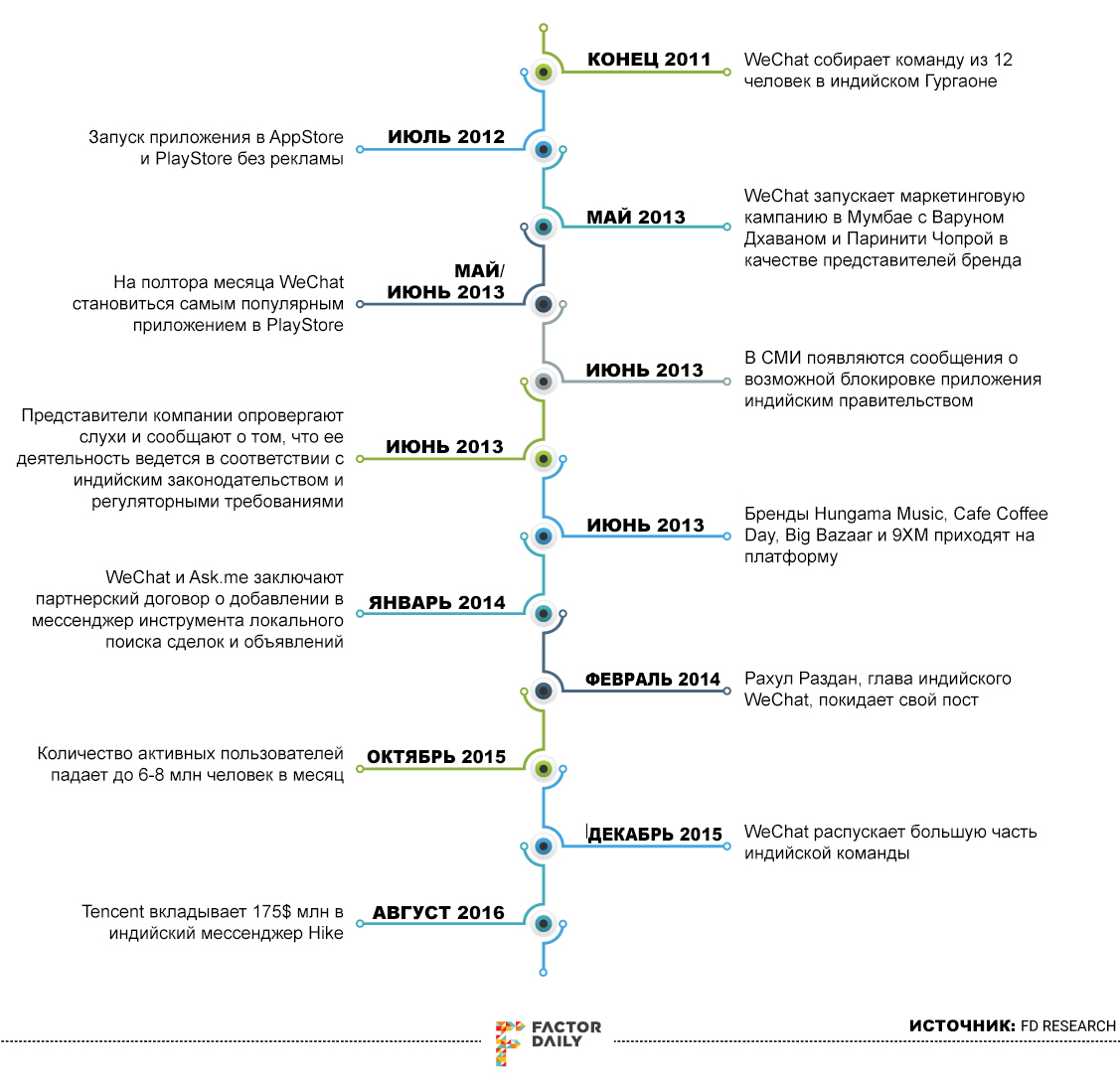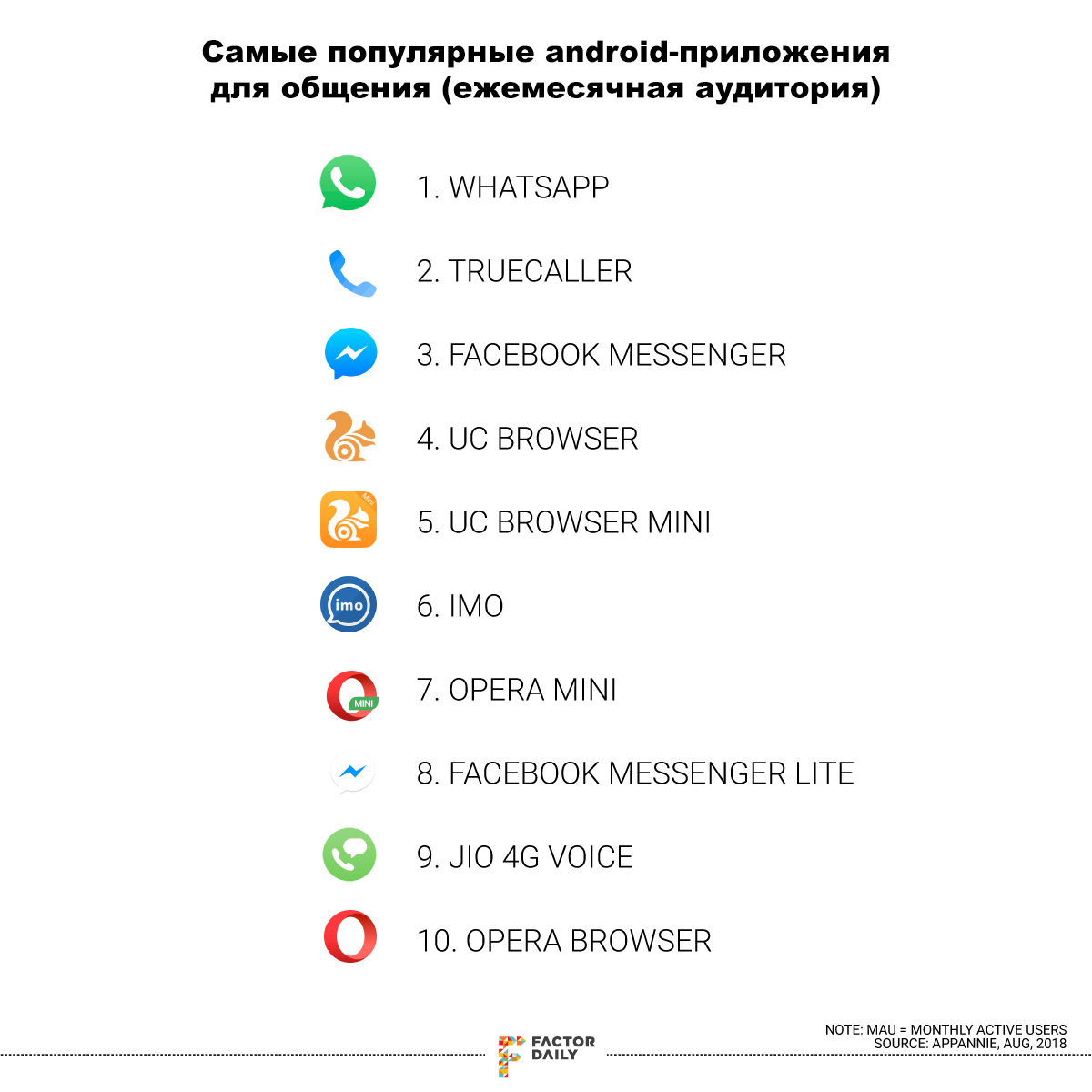WeChat in India: from a powerful launch to a complete loss of interest
- Transfer

“WeChat was the first mobile application to launch a television ad in India. They did not spare funds for this, ”said the former top manager of WeChat India, who wished to remain incognito. Advertising campaigns were conducted on television, radio and in the malls. Local movie stars Pariniti Chopra and Varun Dhavan were offered a lucrative contract, and they became the faces of the brand.
The application started well. "During the advertising campaign, the number of subscribers increased to approximately 20-25 million. For 45 days, WeChat kept on the first line in the Google Play chart," says an anonymous source.
It seemed that the successful Chinese launch script WeChat is repeated in India.
Frame from advertising
Shot from WeChat TV commercial with Pariniti Chopra and Varun Dhawan

Shot from WeChat TV commercial with Pariniti Chopra and Varun Dhawan
But soon the popularity of WeChat abruptly stopped. The number of deletions has increased. Indian users did not rush to regularly use the application. And to top it off, there were reports in the news of a possible government ban on the messenger. This was the beginning of the end of WeChat in India.
The Tencent and WeChat teams refrained from commenting on this topic.
Why did the Indians have a short chat?
Tencent brought together experts from Ibibo, including three or four developers, six marketers and several senior managers to launch the application in India. The team was led by Rahul Hrazdan and Nilai Arora. The latter is currently heading the Indian division of Tencent.
“The product was designed based on the vision of Allen Zhang. WeChat was notable for interesting features that were fired on the Chinese market, but not caught on among Indian users, ”commented Himanisha Gupta, assistant manager for marketing and strategy at WeChat India from 2012 to 2015. He is now the development director at Walnut, a company engaged in lending and cost accounting.

Himanishu Gupta
For example, in the application a “request for friendship” is obligatory, and the interlocutor must certainly accept it before starting a conversation. For comparison, WhatsApp allows you to send a message to any person from your phone’s contact list. That is, it is assumed that the presence of a number in the notebook already indicates the acquaintance of the interlocutors.
The WeChat approach, which obliges friends to add interlocutors, is very similar to the scheme that Facebook still adheres to. This does not allow anyone to see the hidden content of another person until he accepts the sent request. WeChat had to use a similar mechanism, since it is not only an instant messenger, but also a social application with the Moments news feed, which operates similarly to Facebook feed. The issue of restricting access to personal information of users was quite serious.
But this measure has become an additional obstacle that has complicated the correspondence, especially in the case of group chats. Such groups are usually created by one person (admin), inviting people by adding their phone numbers to the list of participants. But in Indian WeChat it was not easy, because the admin had to send everyone a request for friendship and wait for a positive response.
In China, the application has not encountered such obstacles. Most of the Chinese switched to it from the QQ messenger, a product of the time of stationary computers, whose client base at the time of the launch of WeChat had more than 750 million active users per month. Owners of a QQ account transferred their entire social graph to WeChat by simply logging in to the app using QQ ID.
Another WeChat function found other application users in the neighborhood and sent them friend requests. Many people were interested to check the capabilities of WeChat after installation, and they clicked on the “See who's nearby” button. This included an open transfer of the location of the phone. The need to turn off this feature was not obvious to users, and therefore no one did.
“Women began to receive dozens of unwanted requests, and as a result, many of them left the platform,” says Gupta. - "Apparently, in China, problems with persecution did not arise."
Gupta also added that when such incidents were reported to China, the management either missed the cultural nuances or decided that this feature would not be an obstacle to the development of the application in India.
But even so, WeChat had its own audience, which lasted another year, until it moved to WhatsApp. This subsidiary Facebook application supports 10 Indian languages, occupies the largest market share among instant messengers, and in India has a base of 200 million active users as of February 2018.
According to the Indian blogger Suman Prasad, who used WeChat as a student in 2013, many of his friends liked chat rooms, animated stickers and group broadcasts. “WeChat had great potential as a brand. But, I suppose, the developers failed to understand the Indian mentality, and they did not keep up with the changing preferences of young customers, ”says Prasad.
During launch in India, the size of the application was 40 MB. At that time, the internal memory of popular smartphones in the country was no more than 200 MB. And whenever users ran out of space on the phone, WeChat became the main candidate for deletion.
In addition, the application was supported only by Android and iOS systems, while in the Indian market at that time there were still many devices on Symbian and BlackBerry. WeChat is a bit behind the competitors and on this point.
When in 2013 the messenger was at the peak of popularity in the country, news appeared in the media that the Indian government plans to ban the Chinese application. “The fall of WeChat began after the launch of an information campaign discrediting the brand name and stating that officials want to ban WeChat. Up to this point, most users did not even suspect its Chinese origin. They only saw an advertisement with Varun Dhavan and Pariniti Chopra, ”said a former top manager who wished to preserve anonymity.
Difficulty locating
The success story of WeChat in China is phenomenal. There, this application has grown into an ecosystem with a billion users who do everything within the system: order a taxi, buy food, buy movie tickets and even drugs.
In India, the company focused mainly on attracting brands to collaborate, in addition to creating local content like Diwali stickers and providing some technical support to Indian partners. According to Gupta, here, as in China, they wanted to build an ecosystem within which brands would launch promotions and offer discounts. But to attract brands, it was essential to have a growing user base and increase the average time users spend in the application.
Attracting brands to the chat platform is not an easy task. Facebook Messenger is still trying to overcome this stage. It is necessary to increase a large audience, spending a substantial part of the day on the platform, and then somehow segment it. After that, you need to attract brands targeted to certain segments, and make the application constantly in demand. WeChat successfully achieved this goal in China, as it was the most popular application in the country and, thanks to its predecessor, QQ, had data from millions of users.

Analyzing the situation in retrospect, we can conclude that if the marketing efforts of WeChat in India were focused on improving the functionality of the application, and not on attracting brands, the events would take a completely different turn. But, since WeChat at that time was too absorbed in a keen competition with Alibaba in China, the company did not focus on changing the functionality, not related to the Chinese market. Their policy was to take a product that showed itself well in the Chinese market and globally spread it by localizing and strengthening the ecosystem through effective partnerships and aggressive marketing.
In China, where the Internet was cheaper in 2012 than in India, sending a 4 MB video was easy. WeChat did not compress the files, and sending data required much more time and traffic than, for example, WhatsApp, which reduced the size of the photo from 5 MB to 40 kilobytes.
“There is a concept“ product internationalization ‟, which in China denotes the process of translating a product into English and adapting it to users of other countries. But in fact, it does not cease to be the realization of ideas invented by the Chinese and relevant to the Chinese market, ”said the former WeChat top manager, calling it the main reason for the failure of the application in India.
Gupta gives a similar estimate. All changes in the application were cosmetic and were implemented slowly. “Versions for Blackberry and Nokia Symbian still became available, but a year and a half after the start. By that time, the mentioned mobile OSs had already left the stage, and the product that WeChat had lost its initial impulse in the Indian market, ”Gupta believes.
Instant Messenger Market in India
By the time of the publication of WeChat, the Indians had time to get acquainted with the phenomenon of messengers. Even then, WhatsApp was popular in the country, together with mobile operators like Reliance, offering profitable Internet packages for only 16 rupees per month. Facebook has launched its messenger. Indian Hike was launched almost simultaneously with WhatsApp. There was an influx of similar applications, including LINE, Viber, Skype and Hangouts, which offered Indian users voice messages, video calls, free audio calls and stickers.
In February 2013, Hike was at the top of the PlayStore by using the referral program with a reward, but soon lost this position. A few months later, WeChat and LINE launched their marketing campaigns in India.
“Initially, managers of Tencent believed that LINE would be their main competitor, and not WhatsApp, as both messengers aggressively expanded their presence around the world using serious marketing investments,” says Gupta.

Around the middle of 2015, WeChat realized that they were deadlocked in India. A year later, in August 2016, Tencent financed one of the $ 175 million investment rounds in Hike, bringing the value of the latter to $ 1.4 billion. However, Hike still cannot achieve confident monetization and for two years now remains at around 100 million users. It's safe to say that Tencent's rates for instant messengers for the Indian market have not justified themselves.
WhatsApp, on the contrary, went uphill. The application was originally developed for emerging markets, and therefore has such features as a lightweight assembly for weak devices and compression of video and audio information during transmission. Major players WeChat and LINE started in their native markets, Chinese and Japanese, which have a developed infrastructure. They did not fundamentally change the approach and adapt expensive functions for markets with cheap phones, for example, for India in 2013. Instead, companies have decided that over time, the quality of the Internet and technology will improve, and users will appreciate the experience of sharing information that their advanced applications offer.
In India, there was indeed a qualitative leap in 2016 with the launch of Jio. However, the network effect of WhatsApp by that time gained such strength that the application actually became the leader in the market of instant messengers in developing countries.

